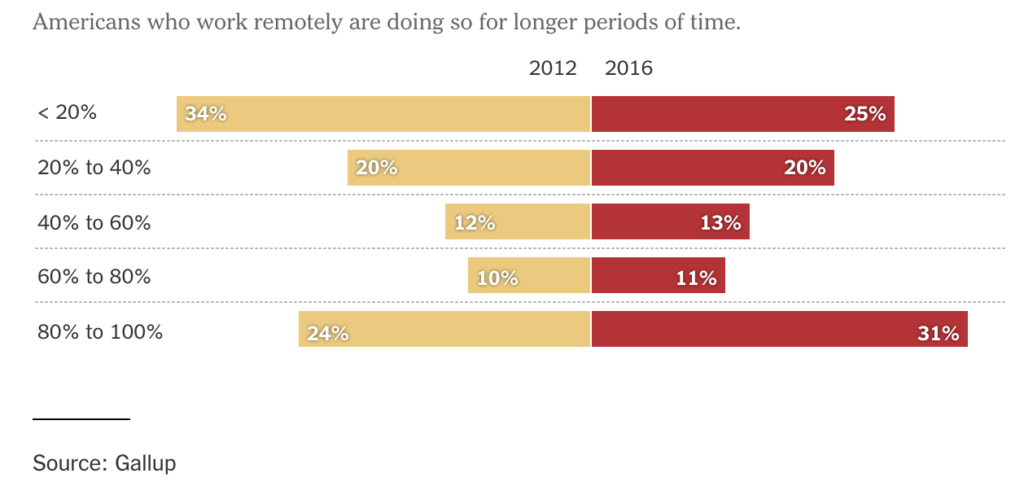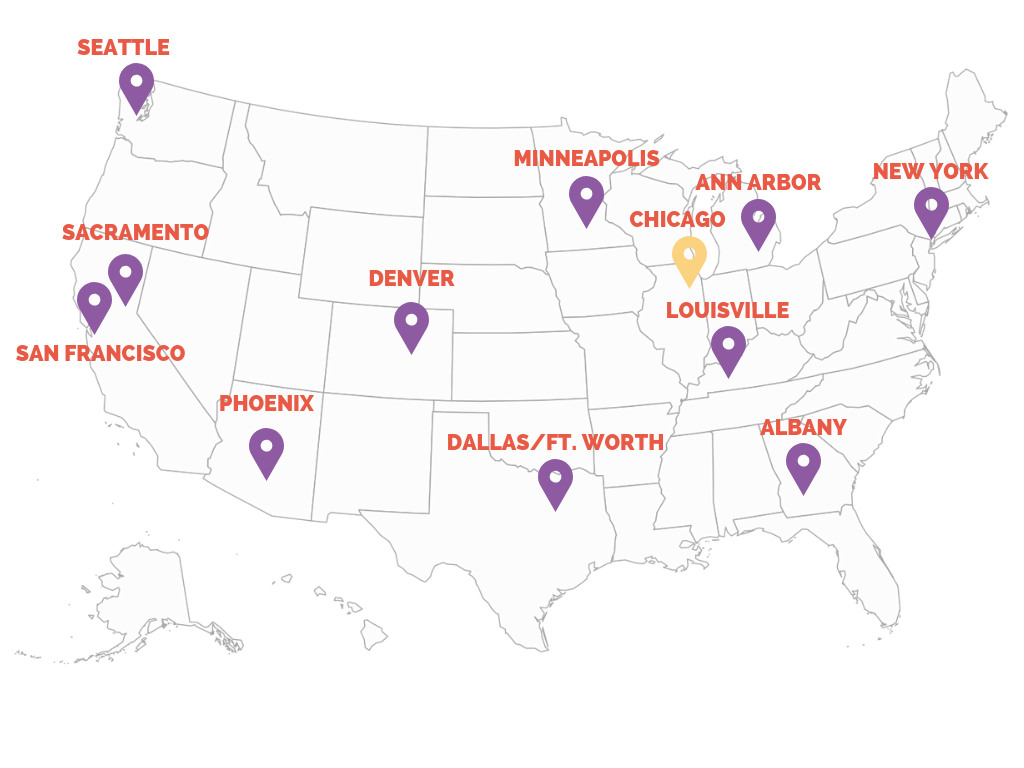Creating a Strong Work Culture When Your Team is Remote

The traditional office environment is disappearing with remote teams and the gig economy taking over. Recent studies show that 63% of employers have a remote team. Also, Gallup research indicates that those workers and spending more and more of their time working remotely.

This talent structure has many benefits: flexibility, time saved not commuting, can hire the best talent wherever they are. It also has its challenges. If you are leading a remote team, you have to adapt your managerial style to accommodate the new format. You don’t have the luxury of swinging by someone’s desk to ask a quick question or keeping a pulse on the team’s morale by just seeing how they are acting. It requires much more intentional effort to keep your team happy, engaged and high-performing.
At Ama La Vida, our team is almost 100% remote. Our coaches are spread out through the US. So we not only are separated geographically, we are also operating within opposite time zones. We’ve learned a lot over the past couple years about how to manage this most effectively and how to still create a strong workplace culture even though we are miles and miles and miles apart.
*Map of locations of our US-based team
Be intentional.
Strong corporate cultures of any kind typically don’t just happen on their own. It takes a concerted effort to cultivate the type of culture you want see. Write down what you want your team’s culture to feel like. Base this on your organization’s values and your own leadership values. Then think about how you can reinforce those values through your actions.
For example, if you want to create a really collaborative team culture, then you need to think about how you can facilitate collaboration and how you’ll recognize and reward it when it happens. This is true of any environment, but the actions required in a remote environment will look different. To get started, write down the top 5 values you want your culture to demonstrate. And come up with one action you will take to help reinforce each.
Make (more!) time for one-on-ones.
When leading team members remotely, you don’t have the ability to sense someone’s mood by being around them. They can’t stop by to ask a question, so they might hold back and wait for a meeting to ask. This makes it more difficult to see how people are feeling and how they are progressing on their work. You can also become a bottleneck in their workflow. Now more than ever, making time for one-on-ones is critical.
Some things you’ll want make sure you cover:
- How they are progressing on their tasks. Of course it’s always important for you to be in the loop on your team’s progress and to give them an opportunity to surface any questions they have for you in order to proceed. However, in a remote team structure, they may actually be waiting for your one-on-one in order to speak with you about their work, so it’s important that you meet at regular intervals.
- How they are feeling. Are they stretched too thin? Bored? Are they feeling disconnected? This is something important to check in on every now and then with every employee. But when you don’t have body language and visual cues to alert you, you simply have to ask!
- Work times and outside commitments. A true beauty of remote work is flexibility. But without fully understanding someone’s schedule you may reduce your assessment of their commitment to whether or not you see some sort of green light showing that they’re online. To avoid assumptions, make sure you ask. Do they need to take a break to pick up their kids from school but come back online later? Do they have doctor’s appointments the first Monday of the month? It’s be helpful for both of you to share when you’ll be offline, so there’s no guessing game.
- How the working relationship can continue to improve. You don’t need to discuss this in every single meeting. But it it will benefit both of you to periodically reflect on what’s working well and what could be better. Maybe you have an idea for how they can provide more transparency around their tasks between check-ins. Or maybe they have a request for how you can be more available to support them. It’s important to continue to refine these things to ensure you are working as happily and productively as possible.
Utilize a collaboration platform.
Slack. Need I say more? There are a variety of online collaboration platforms, but we are completely in love with and dependent upon Slack. For those of you who haven’t used it, Slack is like an instant messenger. Except your conversations are organized by topic and don’t disappear. It has a ton of bots and integrations that can make your life a lot easier as a remote team. Everything from tracking PTO to ordering Taco Bell.
For example we have it linked to our calendars so we can see when our team members are in meetings and know not to bug them. We also have it linked to our CRM, Insightly, so when a new client signs up we get a notification publicly, and we can all celebrate that a new client has come on board.

*Screen shot from a real Slack chat
Soapbox is a platform we recently started using to organize content and action items for team meetings and one-on-one catch-ups. You can connect Soapbox to your calendar so that everything is in sync. You can also connect it to Slack so your team is notified of upcoming meetings and action steps. This makes it easy for them to share agenda items directly from Slack.
Regardless of which platform you choose, remember it takes time for people to get comfortable and use it habitually. Don’t worry if it’s crickets for the first couple months. Keep reminding people of what it is, how it will help with collaboration and productivity and how it works. Eventually they will start to utilize it.
Video is your best friend.
We conduct 90% of our meetings over video. It is a great way to get to see someone’s facial expressions and body language and feel like you are meeting with them in person even if you are very far away. It is always funny to me when I meet our team members in person for the first time after conducting so many video calls with them. I feel like I already know them so well! Regular audio calls are fine for just a quick chat, a question or if you are in transit. Otherwise, try to make video your default.
Zoom is a fantastic video app we use which has a free version. We have tried probably eight different platforms and by far find Zoom to be the most user friendly and innovative as a company. We also like Appear.in for quick calls, especially with folks external to the company because you don’t need to install any software. You simply enter the URL and it loads right up. Appear.in also has a free option.
Loom is another go-to video tool of ours. This one allows you to quickly and easily record a video of your computer screen with the option to have a little circular video of you talking in the corner of the screen like this:

We use Loom any time we want to record a quick training video or tutorial. It operates from a Chrome extension so it’s as simple as clicking a button when you’re on a screen you want to speak about. This helps us provide training to our team in a matter of minutes without having to schedule a meeting, and it’s in a format that is easy to understand and can be reused over and over again.
Have non-work conversations.
When you are physically together, it’s a lot more natural to connect with your colleagues on a personal level. These moments don’t happen organically when you are working remotely, so you have to manufacture them. We have a standing meeting each month where we have a team virtual happy hour over Zoom. It sounds silly, but it’s actually a lot of fun! And we get to chat with one another as people, not just as coworkers.
As a company, we will try and send a small gift to our team members before the happy hour like an Amazon gift certificate so the team can buy whatever snacks or supplies they’d like to have for the happy hour. This month, we will get them some of the ingredients needed for the cooking class. Virtual happy hours and lessons are just one example of how you can create opportunities for authentic personal connections to happen virtually. Get creative, and have fun with this!
Help team members connect with each other one-on-one.
You should certainly facilitate opportunities to connect as a team, but it is also important that team members are forming strong relationships with one another. Trust is a critical component of a high-functioning team, and it’s difficult to build trust without individual connection. Some of this will happen organically, but it is important to also help facilitate these conversations, especially for people who are new. When someone new joins our team, we assign them an “ALV Ally.” This is a person who can serve as a resource for the new hire and can answer any questions they have. This idea isn’t new, and companies have been doing this in an in-person format for some time. However, when you are remote, it is extremely important because people may be scared to ask questions in a public forum and don’t want to bug their boss with a phone call every time.
Donut is a great Slack app which randomly matches two team members at periodic intervals. We have utilized this before to randomly pair team members once a month. We provided everyone with instructions on what to do once matched and some conversation prompts so they had someplace to start to eliminate some awkwardness. You can of course also adopt this practice matching people manually versus with an app and achieve the same benefit.
We also have team members who set up weekend coffee dates with other team members which is a great, informal way to build connections. Coach Teague says, “My biggest advice is to just trust that you will develop those relationships if you put the time in. In fact, because you’re being intentional with the process, you’ll probably form deeper connections than you would in a traditional office setting.”
Reward the right behavior.
Just as you would celebrate and recognize someone for doing their job well or meeting a goal, do the same for those who positively contribute to the culture. This can be as simple and informal as taking a moment to thank someone for supporting another team member. We also love to give the team time and space to highlight these moments to one another. In each of our all hands meetings, we leave time for shoutouts where team members can thank one another or give them recognition for doing a great job or contributing to the team in an important way.

*Actual slide from an all hands deck
If someone consistently goes above and beyond to build the culture, consider giving them a spot bonus or another form or more formal recognition to emphasize that contributing to the culture is just as important as other work contributions.
Knowledge share.
In a high-functioning team, when one team member learns something new, that has a ripple effect throughout the team, and the whole team benefits. When you are all working in different locations, it’s easy for people to operate on islands, feeling they have to learn everything on their own. It’s important to find simple ways to knowledge share so that you can still achieve that communal benefit.
The first method we have to achieve this is our team meetings. In addition to sharing updates and talking about what needs to be done, we also make it a formal practice to share best practices and discuss lessons learned. One way we do this is through roundtable discussions where we highlight client case studies where we had an important learning or made an impact in a new way. We also schedule periodic “Weducations” which are educational sessions on a Wednesday… hence the name. In these sessions we all read or review the same resource, like a TED Talk, and come prepared to discuss our thoughts about it and how it applies to our coaching engagements.
We also have a particular focus on sharing updates and conversations in a public forum. If one of our team members brings to us a client challenge that we think others may encounter, we intentionally ask our team if they mind us sharing it publicly. This helps the entire team can learn from the conversation (of course while maintaining client confidentiality). If someone discovers a great new resource or hack that helps them do their job better, they share it with the whole team.
Invest in periodic face to face when possible.
All of the advice above is important, but nothing replaces the impact of meeting face to face. Of course in-person meetings may be cost prohibitive. But if you can schedule a full team get-together once or twice per year, it will go a long way. Coach Katie says, “Remember that, no matter how great technology is, it can never replace the power of human connection. Find exciting and creative ways to take advantage of the advances in technology, but never leave out the human touch!” These face-to-face meetings don’t need to be in your headquarters location. In fact, it may be logistically simpler, cheaper and more fun to meet elsewhere!

*Proto credit: Ngoc Nguyen
Even though you aren’t physically together, it’s still important to ensure you have a strong culture and feel connected. It may feel uncomfortable or silly at first to get on a video conference just to chat or to reward someone for answering someone’s question on Slack, but it is these things which will ensure your remote team feel supported and engaged. Though you may be far apart, if you follow these tips above, your team is sure to be tightly aligned and excited to commute to their kitchen table or home office for work each day!
If you want to chat with us about how you can enhance your remote team leadership, get in touch with us here.









